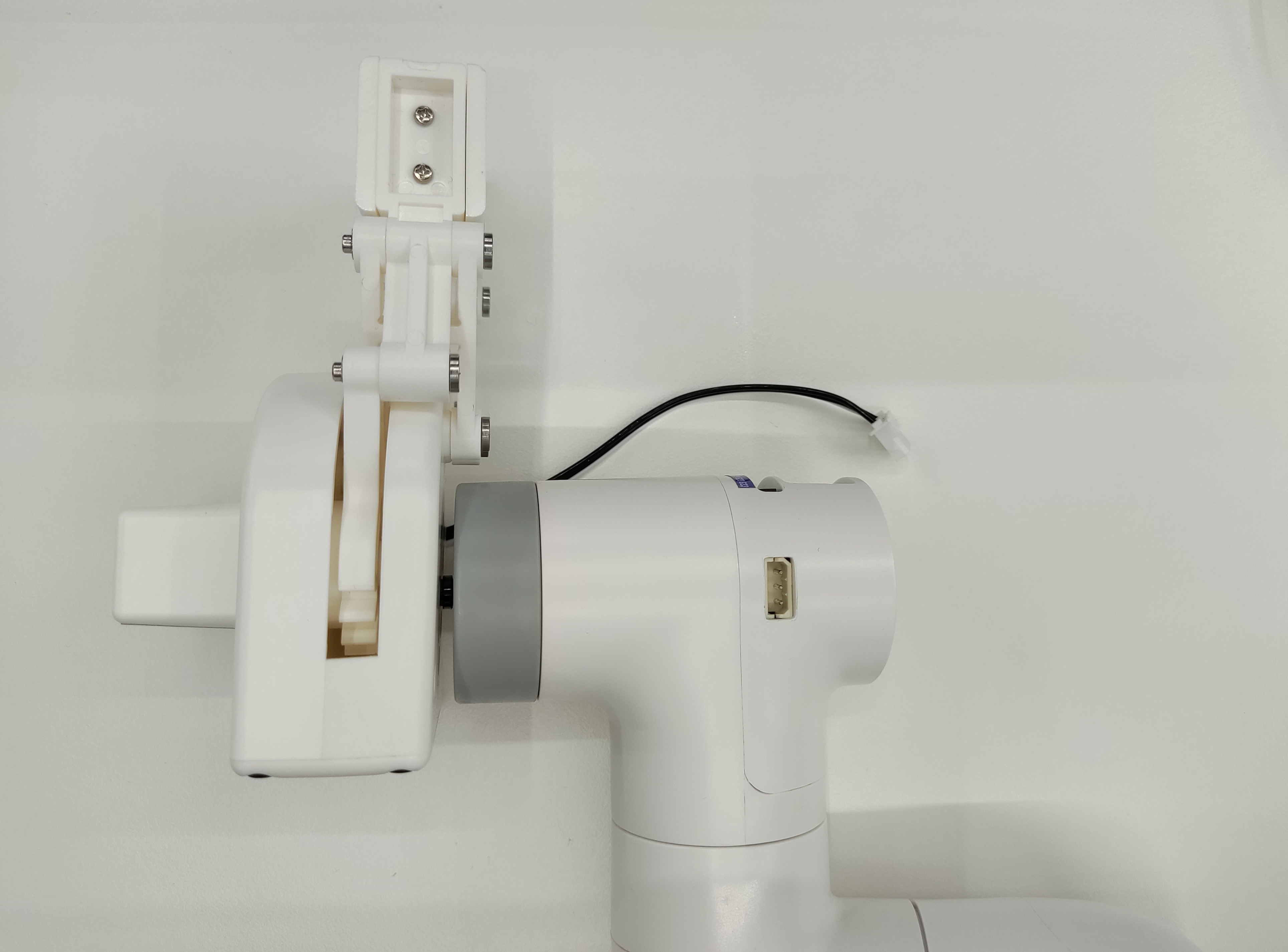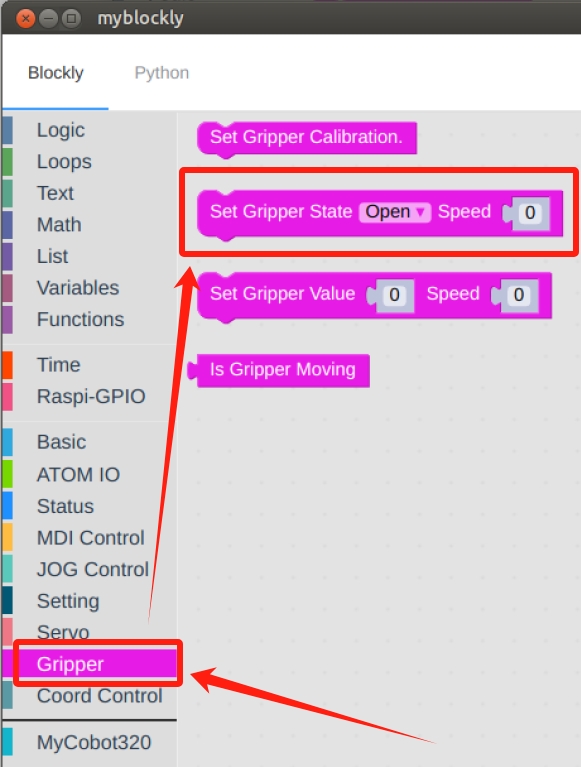Adaptive Gripper
Compatible models: myCobot 280, myPalletizer 260, mechArm 270
product icon

Specifications:
| name | mycobot280 adaptive gripper |
|---|---|
| Model model | myCobot_gripperAg_white |
| craft | ABS injection molding |
| color | White |
| Clamp size | 20-45mm |
| Clamp force | 150g |
| Repeatability precision | 1mm |
| Lifetime | one year |
| drive mode | electric |
| transfer method | gear + connecting rod |
| size | 112×94×50mm |
| weight | 100g |
| Fixed method | Lego Connectors |
| Use environment requirements | Temperature and pressure |
| control interface | serial control |
| Applicable equipment | ER myCobot Series 280, ER myPalletizer Series 260, ER mechArm Series 270, ER myBuddy Series 280 |
Adaptive Gripper: Gripping objects using
Introduction
- A gripper is a robotic component that can function like a human hand. It has the advantages of complex structure, firm grasping of objects, not easy to drop, and easy operation. The gripper kit includes gripper accessories and LEGO high-tech parts. The end effector of the robotic arm is controlled by a programmable system to realize functions such as grasping and multi-point positioning of objects. Gripper can be used in all development environments, such as ROS, Arduino, Roboflow, etc.
working principle
- Driven by a motor, the finger surface of the gripper makes a linear reciprocating motion to realize the opening or closing action. The acceleration and deceleration of the electric gripper is controllable, the impact on the workpiece can be minimized, the positioning point is controllable, and the clamping is controllable .
·
Applicable object
small cube
small ball
long object
Installation and use
Check that the kit has everything: LEGO connectors, clamping claws with connecting wires, connecting wire extensions

Jaw mounting:
Structure Installation:
Insert the LEGO connectors into the sockets reserved for the clamping jaws, which can be installed in two different directions as required:
Method 1
 Method 2
Method 2

Insert the jaws of the inserted connection against the end socket of the robot arm:
Method 1
 Method 2
Method 2

Electrical Connections:
- Connect the extension cord to the jaws:

- Plug in the robotic arm control interface:

Method 1
Method 2
- Connect the extension cord to the jaws:
Software-driven testing:
To test if the jaws are available after installation, use myBlockly. myblockly download
- After confirming that the structural and electrical connections are complete, start the arm and open the myblockly software when the graphical interface appears.

- Modify the baud rate to 1000000

- Find the
Jaws' in the list on the left and select theStatus Settings' module.
- The drag module is connected under
initialise mycobot module, modify the speed as needed, here it is set to70
- In
Time, selectSleepmodule
- Setting the time to
2 secondsis intended to give the time for the jaws to move.
- Repeat the selection of the
State SettingsandSleepmodules to change theState Settings Moduleto Off.
- Click on the green run icon in the top right corner to see the jaws open and close once
- After confirming that the structural and electrical connections are complete, start the arm and open the myblockly software when the graphical interface appears.
Programming Development:
Programming the jaws using python
python downloadCreate a new python file:
Ctrl + Alt + TOpen the command line and type:gedit grip.py
The file name can be changed as needed
Perform function programming:

The code is as follows:
- M5 version:
from pymycobot import MyCobot280 import time # Initialise a MyCobot280 object mc = MyCobot280("COM3", 115200) # All three of the following control the jaws open-close-open # Method 1: mc.set_gripper_state(0, 80) time.sleep(3) mc.set_gripper_state(1, 80) time.sleep(3) mc.set_gripper_state(0, 80) time.sleep(3) # Method 2: # mc.set_gripper_value(100, 80) # time.sleep(3) # mc.set_gripper_value(0, 80) # time.sleep(3) # mc.set_gripper_value(100, 80) # time.sleep(3) # Method 3: # mc.set_encoder(7, 2048) # time.sleep(3) # mc.set_encoder(7, 1500) # time.sleep(3) # mc.set_encoder(7, 2048) # time.sleep(3)- Pi version:
from pymycobot import MyCobot280 from pymycobot import PI_PORT, PI_BAUD # When using the Raspberry Pi version of mycobot, these two variables can be referenced for MyCobot280 initialisation import time # Initialise a MyCobot280 object mc = MyCobot280("COM3", 115200) # All three of the following control the jaws open-close-open # Method 1: mc.set_gripper_state(0, 80) time.sleep(3) mc.set_gripper_state(1, 80) time.sleep(3) mc.set_gripper_state(0, 80) time.sleep(3) # Method 2: # mc.set_gripper_value(100, 80) # time.sleep(3) # mc.set_gripper_value(0, 80) # time.sleep(3) # mc.set_gripper_value(100, 80) # time.sleep(3) # Method 3: # mc.set_encoder(7, 2048) # time.sleep(3) # mc.set_encoder(7, 1500) # time.sleep(3) # mc.set_encoder(7, 2048) # time.sleep(3)Save the file and close it, return to the command line terminal and type:
python grip.py
You can see the jaws open-close-open